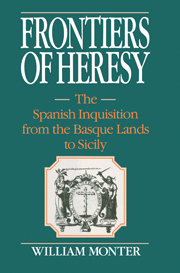Book contents
- Frontmatter
- Contents
- List of maps and figure
- List of tables
- Preface
- PART 1 THE HOLY OFFICE OUTSIDE CASTILE
- PART 2 ARAGONESE TRIBUNALS
- PART 3 ARAGONESE HERESIES
- PART 4 “MIXED CRIMES” IN ARAGON
- 12 Witchcraft: the forgotten offense
- 13 Sodomy: the fateful accident
- PART 5 RECESSIONAL
- APPENDICES
- Glossary
- Index
- CAMBRIDGE STUDIES IN EARLY MODERN HISTORY
13 - Sodomy: the fateful accident
Published online by Cambridge University Press: 24 October 2009
- Frontmatter
- Contents
- List of maps and figure
- List of tables
- Preface
- PART 1 THE HOLY OFFICE OUTSIDE CASTILE
- PART 2 ARAGONESE TRIBUNALS
- PART 3 ARAGONESE HERESIES
- PART 4 “MIXED CRIMES” IN ARAGON
- 12 Witchcraft: the forgotten offense
- 13 Sodomy: the fateful accident
- PART 5 RECESSIONAL
- APPENDICES
- Glossary
- Index
- CAMBRIDGE STUDIES IN EARLY MODERN HISTORY
Summary
Sin duda el pecado-delito que … quizá en general, más horrorizaba y escandalizaba, sobre todo durante los siglos XVI y XVII, era el de sodomía … Se le llamaba comúnmente el “pecado nefando” o simplemente “el pecado,” como si se tratase del pecado por antonomasia.
Tomás y Valiente, Derecho penal, pp. 226–27De este nefando delito, indigno de nombrar, destruidor del orden natural, castigado por el juicio divino, por el cual la nobleza se pierde, el corazón se acobarda y se engendra poca firmeza en la fé … y nace del mucho denuesto y oprobrio a las gentes y tierra donde se consiente.
Fray Pedro de León, SJ (quoted by Herrera Puga, Sociedad y delincencia, p. 262).Aúnque sabía que es gran pecado, no sabía que esto fuese del conocimiento del Santo Oficio.
Forty-seven-year-old Catalan defendant in Aragon, 1630 (Inq., Libro 992, fol. 7iv).In January 1524, the Suprema received a petition from a prominent citizen of Saragossa, Don Sancho de la Caballería, alleging that the Fiscal or prosecutor of the Aragonese Inquisition had formally charged him with the “unspeakable sin of sodomy” through the machinations of his personal enemies. Don Sancho complained that his arrest was patently illegal, “this charge not belonging to your jurisdiction, and such crimes never having been tried by you nor other Inquisitors.” The Suprema ordered the Saragossa tribunal to send the trial records to them and do nothing until further notice, but not to release Don Sancho
- Type
- Chapter
- Information
- Frontiers of HeresyThe Spanish Inquisition from the Basque Lands to Sicily, pp. 276 - 300Publisher: Cambridge University PressPrint publication year: 1990



